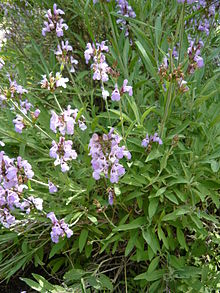| Salvia officinalis subsp. lavandulifolia | |
|---|---|

| |
| Scientific classification | |
| Kingdom: | Plantae |
| Clade: | Tracheophytes |
| Clade: | Angiosperms |
| Clade: | Eudicots |
| Clade: | Asterids |
| Order: | Lamiales |
| Family: | Lamiaceae |
| Genus: | Salvia |
| Species: | S. officinalis |
| Subspecies: | S. o. subsp. lavandulifolia |
| Trinomial name | |
| Salvia officinalis subsp. lavandulifolia (Vahl) Gams | |
| Synonyms | |
| |
Salvia officinalis subsp. lavandulifolia, synonym Salvia lavandulifolia, (Spanish sage) is a small woody herbaceous perennial native to Spain and southern France, growing in rocky soil in Maquis shrubland, often found growing with rosemary, Lavandula lanata, and Genista cinerea.
S. officinalis subsp. lavandulifolia grows 30 centimetres (1 ft) tall and wide, with a reclining habit and narrow, lanceolate, whitish-gray evergreen leaves that are less than 50 mm (2 in) long. The leaves grow opposite each other on the stem and appear to grow in bunches. When the leaves are rubbed, oils give off a fragrance similar to rosemary. These oils are used for scenting soaps. The 25 mm (1 in) long, pale lavender flowers grow on short inflorescences, blooming for about one month in late spring and early summer. The flowering stems have very few flowers on widely spaced whorls. Some varieties have a dark calyx.
Biochemistry
The essential oil of S. officinalis subsp. lavandulifolia has been found to have a selective acetylcholinesterase-inhibiting effect, (in as far as the regions of the brain in which acetylcholinesterase activity has been demonstrated, such areas are striatum and hippocampus) with an IC50 value of 0.03 μg/ml. The chief reason for this activity are believed to be the monoterpenes 1,8-cineole and α-pinene which have IC50 values of 0.67 and 0.63 mM, respectively.
Medical effects
A 2003 study indicated that S. officinalis subsp. lavandulifolia improves word recall in healthy young adults.
References
- "Salvia officinalis subsp. lavandulifolia (Vahl) Gams". Plants of the World Online. Royal Botanic Gardens, Kew. Retrieved 2024-04-30.
- ^ Clebsch, Betsy; Barner, Carol D. (2003). The New Book of Salvias. Timber Press. p. 198. ISBN 978-0-88192-560-9.
- Houghton PJ. Personal communication. (in book Herbal Medicines, Third edition by: Joanne Barnes, Linda A Anderson and J David Phillipson)
- Perry NSL et al. In-vitro inhibition of human erythrocyte acetylcholinesterase by Salvia lavandulaefolia essential oil and constituent terpenes. J Pharm Pharmacol 2000; 52: 895–90
- Tildesley, N. T.; Kennedy, D. O.; Perry, E. K.; Ballard, C. G.; Savelev, S.; Wesnes, K. A.; Scholey, A. B. (2003). "Salvia lavandulaefolia (Spanish sage) enhances memory in healthy young volunteers". Pharmacology Biochemistry and Behavior. 75 (3): 669–674. doi:10.1016/S0091-3057(03)00122-9. PMID 12895685. S2CID 22451799.
External links
 Media related to Salvia officinalis subsp. lavandulifolia at Wikimedia Commons
Media related to Salvia officinalis subsp. lavandulifolia at Wikimedia Commons- "Salvia lavandulifolia". Plants for a Future.
| Taxon identifiers | |
|---|---|
| Salvia officinalis subsp. lavandulifolia | |
| Salvia lavandulifolia |
|
This Salvia article is a stub. You can help Misplaced Pages by expanding it. |